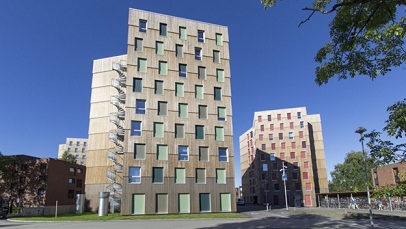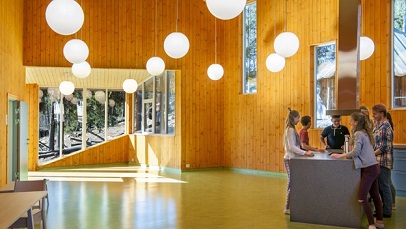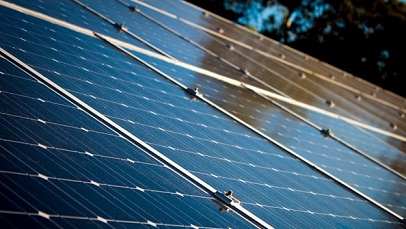
Whether you’re starting from scratch or renovating a new building (hotel, school, business center, etc.), there’s more to a building than just obtaining the cheapest or most commonly used materials to get the job done. Now that more and more builders like builders in Essex are incorporating green building techniques, there are new and innovative methods that offer style, affordability, and durability, and that mesh with the 21st century.
Choosing the right eco-friendly and sustainable building materials are paramount to staying on top of modern trends to make appealing buildings, as well as incorporating cutting-edge materials to ensure that your building stands the test of time.
Here are six sustainable building design considerations for commercial buildings.
 Low-Maintenance Exteriors
Low-Maintenance Exteriors
In addition to the ecological benefits, low-maintenance exteriors come with durability to withstand the elements and give a modern look to new buildings. These exteriors include:
Fiber cement siding: As a composite material made of cement that’s been reinforced with cellulose fibers (plant-based), your building can be resistant to rot, termites, and impact (i.e. airborne debris in high-wind). Additionally, modern fiber cement siding has fireproof properties that make it an ideal choice for a safer building.
Modified wood siding: Rethink what you’ve thought about wood as a sustainable long-term building material. With wood siding your building can feature a natural look, but incorporate increased decay resistance, dimensional stability, and an impressive hardness not traditionally thought of. Best of all, visually-appealing woods like beech, ash, birch, alder, and other varieties can be used.
Steel siding: Using the various modern alloys of steel, your building can benefit from steel siding that not only reinforces the structure, but can offer an impressive visual impact and speak volumes about your building’s modern ecological style.
Natural Interiors
 Using eco-friendly interior materials can add a perceptible warmth and charm to a building. For instance, interior wood cladding brings a modern look, with its limitless staining and finishing options. Considering that wood cladding doesn’t emit pollutants during the manufacturing process and can last decades with proper maintenance, it’s a go-to for modern designers that want to add value to their building.
Using eco-friendly interior materials can add a perceptible warmth and charm to a building. For instance, interior wood cladding brings a modern look, with its limitless staining and finishing options. Considering that wood cladding doesn’t emit pollutants during the manufacturing process and can last decades with proper maintenance, it’s a go-to for modern designers that want to add value to their building.
There’s also the benefits of stone accent walls, which is ecologically-sound and makes a beautiful statement, whether it is flat surface, layered brick, or polished tile.
Engineered Flooring
Engineered flooring is a great option for sustainability and endurance, especially in high-trafficked walkways. Most engineered hardwood floors are comprised of layers, responding well to moisture, humidity and temperature—something that’s plagued traditional flooring materials. There’s also the tactile feel that one gets when walking on engineered flooring, the nexus between comfort and functionality that eco-minded builders seek to incorporate.
 Eco Friendly Insulation
Eco Friendly Insulation
When one thinks of insulation, it’s typically the pink fiberglass material—which isn’t very eco-friendly. With eco-friendly insulation materials, like ecologically friendly building wrap, your building can benefit from improved air circulation and moisture control. This includes passive designs, which require little maintenance and avoids the environmental and health hazards with traditional insulation.
Improved Waste Management
Most commercial buildings and facilities are spending too much money and energy because of inefficient waste management systems. Many buildings are being designed with eco-friendly plumbing, like drainage systems that have improved on the retrofitted designs of yesteryear. Some of these emerging designs for green plumbing include steel/PEX pipes for heat retention and longevity, eco-friendly toilets that significantly reduce water bills, outdoor water systems that recycle water, and sanitary drainage systems that improve the health of the building’s occupants.
Solar Panel Installation
 There’s been an emerging trend of using solar energy for building maintenance, which is done by solar panel installation. Not only do they reduce power consumption and power the building itself, but there’s been a shift from the old, clunky designs into a hyper-modern design that is stunning to behold.
There’s been an emerging trend of using solar energy for building maintenance, which is done by solar panel installation. Not only do they reduce power consumption and power the building itself, but there’s been a shift from the old, clunky designs into a hyper-modern design that is stunning to behold.
For instance, Smartflower Solar Panels and Stanford University’s Central Energy Facility is a standout example of elegant design with solar panel installation. The structure elegantly obscures heavy-duty infrastructure with metal screens, including a shade trellis that doubles as a solar array, powering the entire building.
Consider Sustainable Designs for Your Building
As you can see, when you’re designing or refurbishing your buildings, incorporating eco-friendly materials can bring new levels of functionality to how structures look and perform for the future. Whether it is the incredible cost benefits from investing in solar, the beautiful visuals that come from interior wood cladding, the long-term investment with sanitary drainage systems, or the feel of engineered wood flooring, sustainable building design is a consideration that builders and architects of the future must incorporate to ensure a bright and sustainable future for the world.
About the Author
Matt Lee is a freelance writer for building material manufacturers who founded Innovative Building Materials. He covers various construction topics and design concepts with a focus on sustainable and stylish building materials.






